UMF student Isaiah Wilson-McFarlane ’20 comes oh-so close to capturing an elusive, nocturnal vision of Smalls Falls.
If you’ve been following the work of photographer and science writer Isaiah Wilson-McFarlane ’20 in Farmington First, you know that Smalls Falls, some 40 miles north of campus, is his muse. He’s trained his lenses on the series of picturesque cascades in Township E in all manner of weather and throughout the seasons. Despite capturing stunning images that showcase its power and beauty, Wilson-McFarlane says one vision of the hydrogeologic marvel remains elusive: Smalls Falls at night. For his May 2019 reflections, Wilson-McFarlane explains how he recently came close to realizing the goal of his mind’s eye.
— Marc Glass, director of advancement
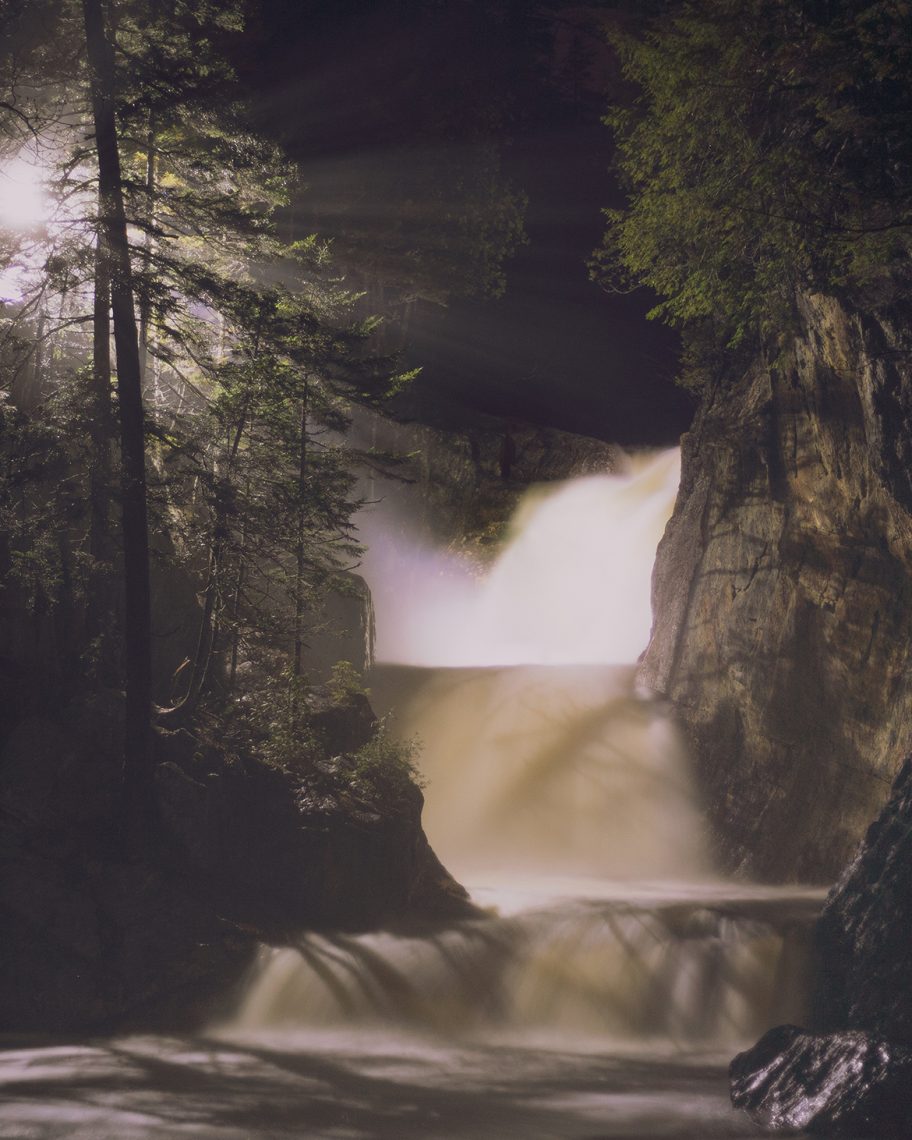
An image two years in the making. Read on to learn why Wilson-McFarlane remains undaunted in the search for the impossibly perfect picture.
Since the beginning of my journey into landscape photography in the summer of 2017, I have been drawn to Smalls Falls next to route 4, on the way to Rangeley for several reasons. The location is a landscape photographer’s playground, with beautiful red and green, half-billion-year-old Silurian schist cliffs; worn red cedar trees clinging to the rocks; and wonderful lines carved by thousands of years of sediment flow through the bedrock lining the river.
I have fallen in love with the area and spent countless hours there swimming and photographing, as well as scheming of ways to show the falls in interesting and less familiar ways. I have been at Smalls Falls during thunderstorms, hailstorms, the first snow of the year, in the late fall when there is hardly any water moving downstream, and even during a massive rainfall event in November 2018, when the flow recorded downstream in Madrid was almost twice that of the average for that month.
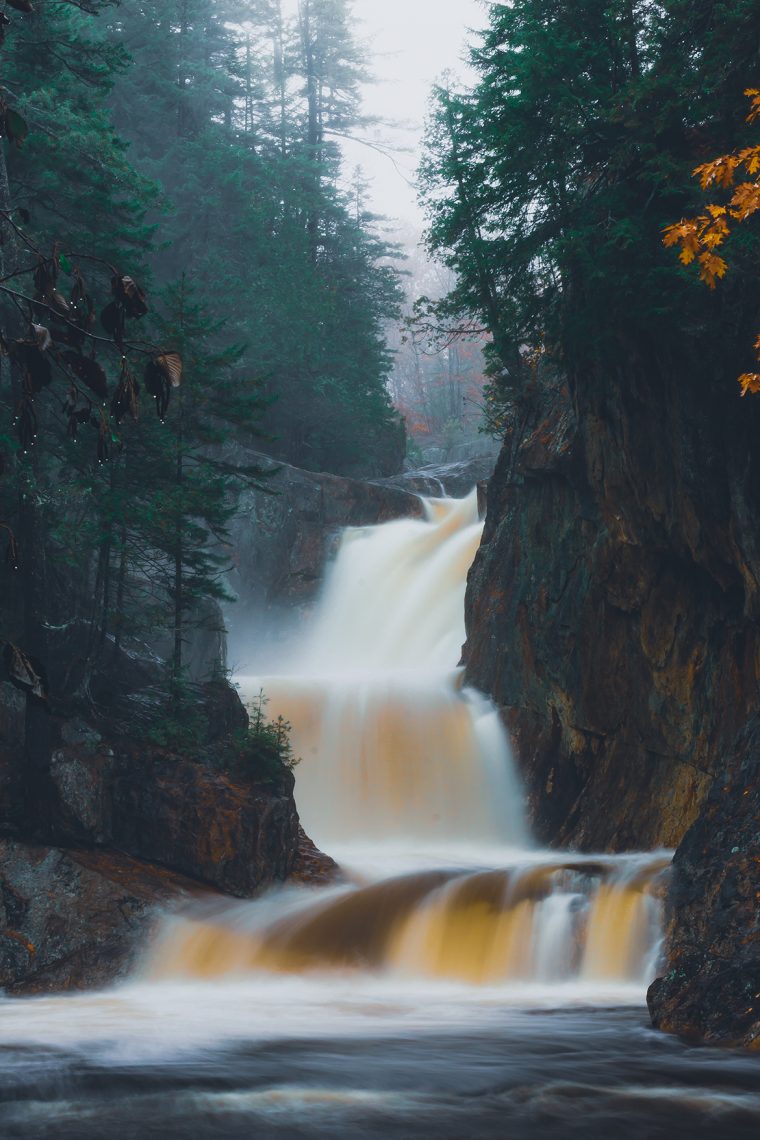
Wilson-McFarlane approached the high-water mark of his vision for Smalls Falls during a torrential November 2018 rain storm.
I was able to capture amazing changes in the way that Smalls Falls looks and even feels during all of those times. But the biggest challenge that I don’t think I will ever be completely satisfied with is Smalls Falls at night. I made my first attempt at showing the falls at night in fall 2017. My complete lack of knowledge of how to set up a long exposure with light painting meant I was going into the situation blind. I had an idea of what I wanted in my head and nothing else. I used a wide angle 22mm lens on my Canon Rebel T3 and took a single exposure with my friend sitting on a rock near the waterfall waving a flashlight around to hopefully illuminate the scene. At the time I was excited and impressed with what the back of the camera showed me even though it was not what I had envisioned. Now, looking back at the first attempt, I can only see the improvements in technique and camera control I have made in the past two years.
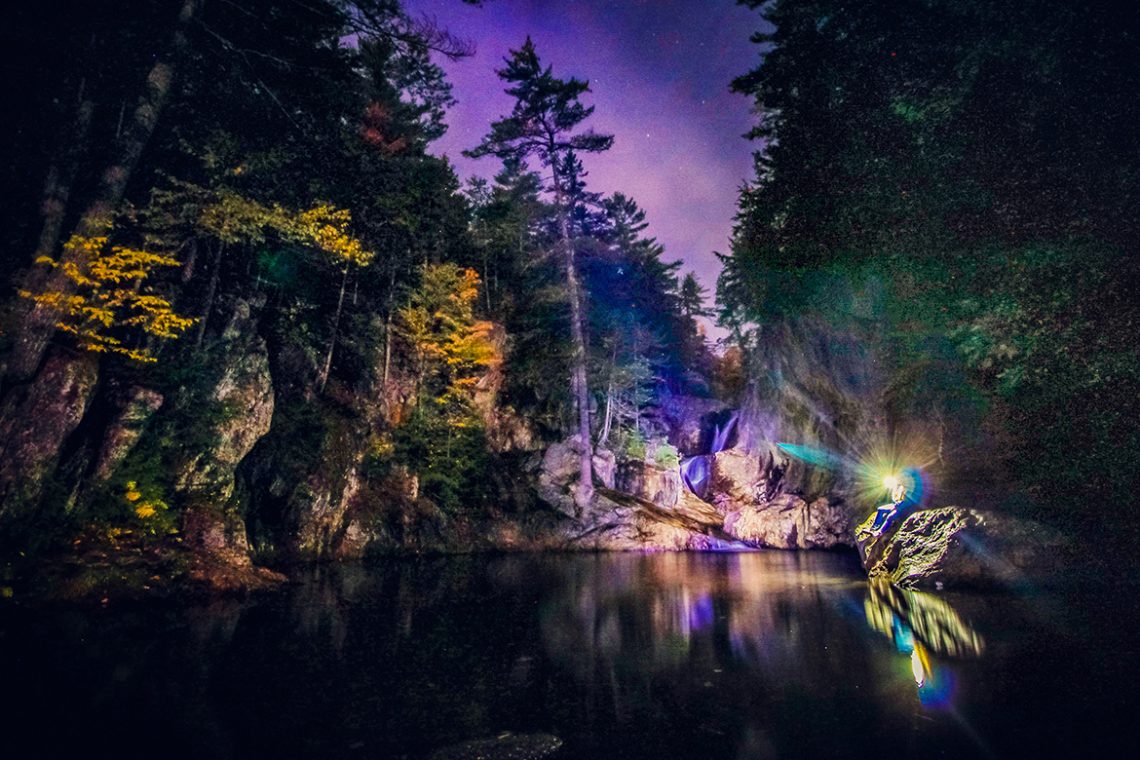
For his first attempt in fall 2017, Wilson-McFarlane asked a friend to illuminate the scene by waving a flashlight on the rocks during a long exposure.
I went back to the falls at night before my summer internship in Arizona began in May 2018 to try again because I still hadn’t realized the vision in my head. I ditched the wide angle lens for a tighter and more intimate 50mm lens and used it to remove distracting parts of the previous attempt in an effort to make the image more clear and concise. I used a similar method of lighting the falls with a flashlight to hopefully make a nice contrast between the lit up falls and the dark water rushing below past my tripod. The silhouette in the bottom allows the viewer to more easily place themselves within the landscape, and hopefully perceive the image more intuitively. It was definitely an improvement over the first attempt I had made the previous year, but there were several issues I had with the image. Because of how bright the flashlight was, it made the sculpted walls of the cliffs look one-dimensional, and the single-source lighting didn’t allow for any reflected light to bounce around the area and soften up the shadows. I had yet to have the skills and understanding of lighting dynamics to improve on the image.
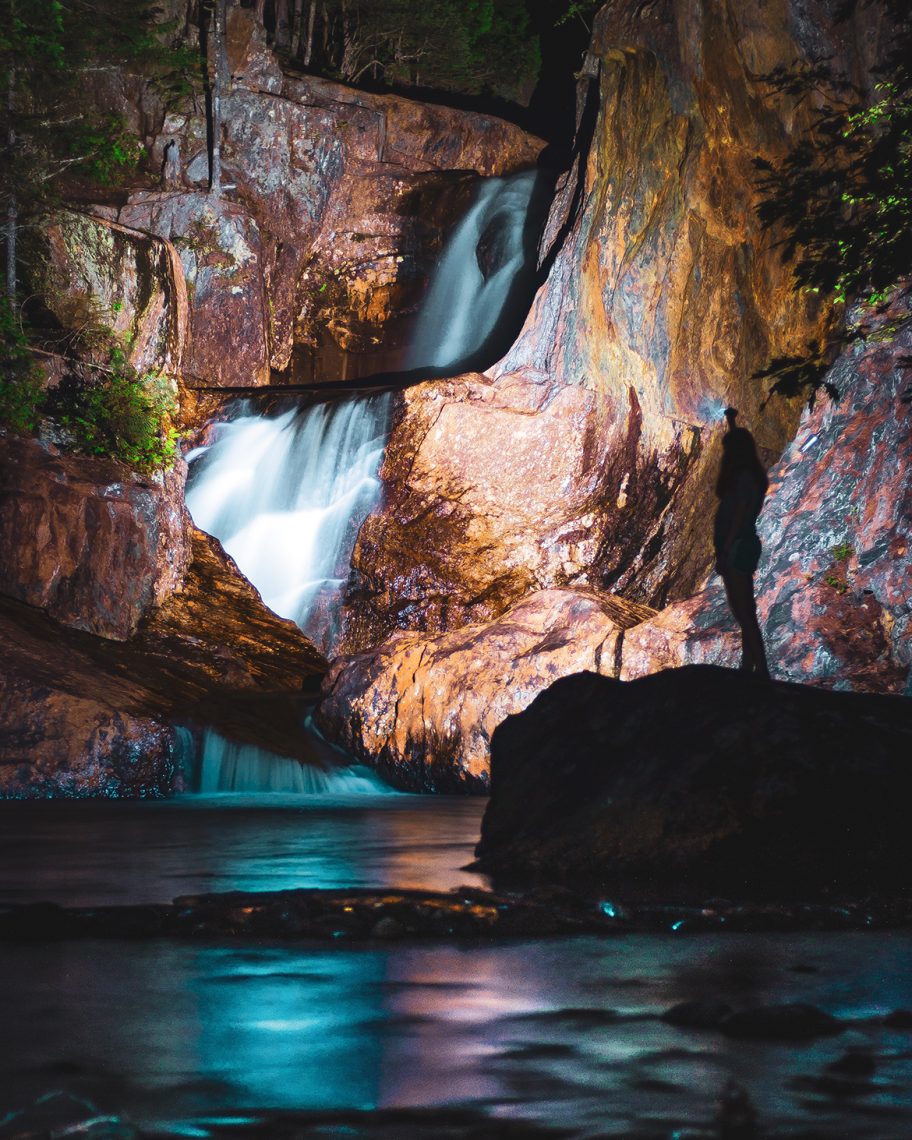
In this May 2018 attempt, Wilson-McFarlane says the silhouette in the foreground provides scale, but ideal lighting remains unrealized.
During a more laid-back night on finals week a few weeks ago, my friend Stuart and I were trying to find a way to distract ourselves from the stress of upcoming finals when I suggested we go to Smalls Falls again. This spring has been very wet, and I figured the falls would be free of snow, and at peak flow for the season. The second we stepped out of his car in the parking lot, the deafening sound of water hit our ears, and my assumptions about the spring conditions of the falls were confirmed. As we crossed the bridge below the falls and stood in the mist, cold air flowing over us, I almost had a knot in my stomach. There is something sublime about how powerful waterfalls are. The fact that we couldn’t see it unless I turned my flashlight on and illuminated the roaring, cacophonous falls reminded me of when I was little, walking around the house late at night, half expecting a monster to be in the living room, hiding in the dark.
I set my tripod up on the bridge and began adjusting shutterspeed and iso (film speed) settings, trying to expose long enough to make the water look soft and billowy. My first attempt suffered the same issue that plagued my 2018 try. My flashlight made everything look one-dimensional, and lacking a subject. For my second attempt, Stuart went up the falls to the second tier, and I captured an 8-second exposure of his flashlight illuminating the falls. It was too far in the opposite direction, where nothing was lit and, the part that was illuminated wasn’t clear.
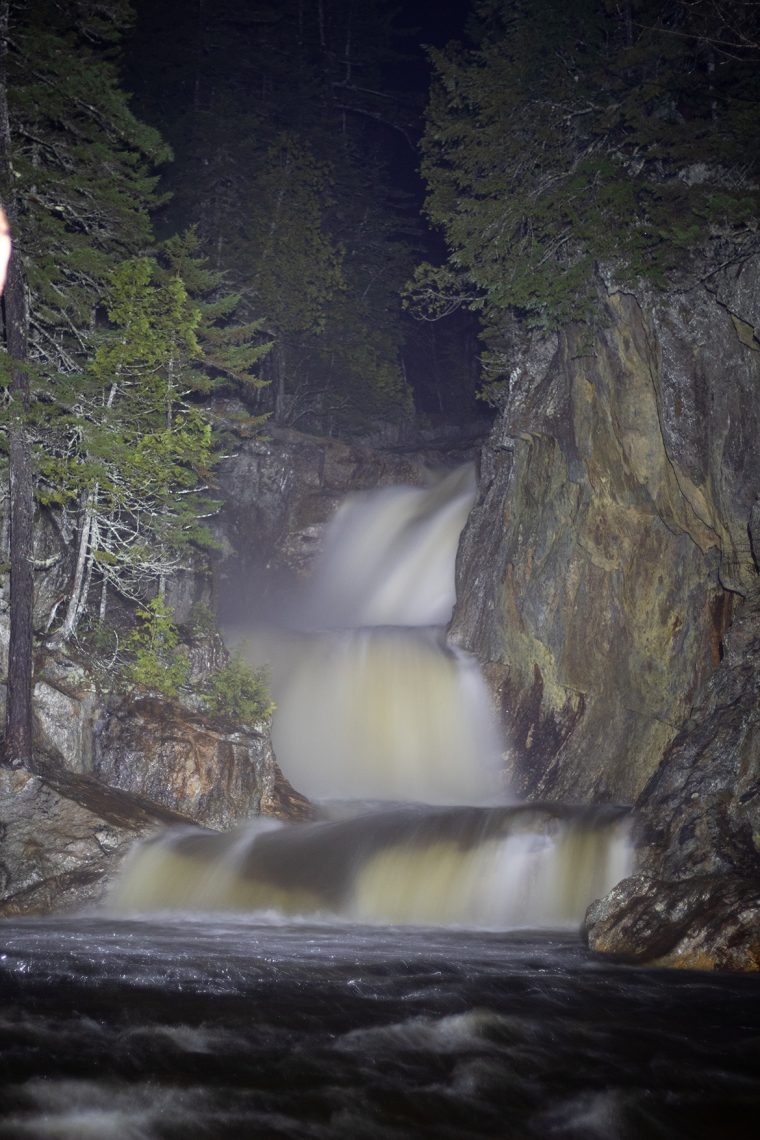
Evenly lit, but lacking the drama Wilson-McFarlane envisioned.
For my third attempt, I waited until Stuart moved behind the large conifer to the immediate right of the falls, and flashed my light from the bridge for a moment to give some context to the composition. The combination of lights allowed for a very soft, almost 3D image that I could walk into, and Stuart’s light gave a clear subject to the scene that interacted well with the rest of the falls. I was very excited by this image because it is the closest to what I have in my head for a night image of the falls.

The right interplay of shadows, textures, colors, and light — for now.
Over time, as I have slowly improved my photography skills, I have moved away from looking through landscapes, waiting for a composition to pop out at me. Instead, through practice, I have given myself the tools to search for the compositions in my mind’s eye. It’s a transition I couldn’t have predicted when I began my work with landscape photography. I also have come to terms with the fact that the “perfect image” will never be taken. I have begun to appreciate how much photography allows me to be critical of myself in a constructive way; one that allows for the journey between milestones. I don’t think that I will ever take the image of Smalls Falls at night that I can see in my head, but it’s oddly comforting knowing that I will always be able to try, and there isn’t an end to the challenge that is photography.

